Monday, November 11, 2024
How to Build a Small Boat: Easy DIY Plans and Guide

Building a Small Boat: Easy DIY Plans and Guide
Embark on an exhilarating journey of boatbuilding with this comprehensive guide, offering simple DIY plans and expert advice. Whether you're a seasoned craftsman or a novice enthusiast, this step-by-step approach will empower you to construct your own small boat.
Choosing the Right Boat Design
The first step in this exciting endeavor is to select the perfect boat design that aligns with your skills, resources, and intended use. Consider these factors:
Boat Type
- Rowboat: Ideal for leisurely paddling on calm waters, rowboats offer a classic and tranquil boating experience.
- Dinghy: Designed for smaller bodies of water and easy portability, dinghies are perfect for exploring coves and inlets.
- Kayak: Providing a low-profile and efficient paddling experience, kayaks are perfect for navigating rivers, lakes, and even coastal waters.
- Canoe: Known for their versatility and stability, canoes are suitable for a wide range of water conditions, from calm lakes to gentle rivers.
Boat Size
The length and width of your boat will influence its stability, capacity, and ease of handling. A smaller boat will be easier to build and transport, while a larger boat can accommodate more passengers and cargo.
Materials
Choose materials that align with your budget and skill level. Popular options include plywood, fiberglass, cedar, and even recycled materials. Plywood offers affordability and ease of workability, while fiberglass provides superior durability and water resistance.
Gathering Tools and Materials
Once you have chosen your boat design, gather the necessary tools and materials to ensure a smooth and successful building process.
Essential Tools
- Measuring Tape: For accurate measurements of your boat's dimensions.
- Saw: A circular saw or jigsaw for cutting wood, plywood, or fiberglass.
- Drill: For creating holes and securing fasteners.
- Screwdriver: Essential for assembling components and securing screws.
- Clamps: To hold pieces together during assembly.
- Sandpaper: To smooth surfaces and remove imperfections.
- Epoxy Resin and Hardener: For bonding wood and fiberglass, ensuring watertight seams.
- Fiberglass Cloth: To reinforce and protect the boat's hull and deck.
- Paint: To provide a protective coating and enhance the boat's appearance.
Materials
- Plywood or Fiberglass: The primary material for the boat's hull and deck.
- Wood Strips or Battens: For adding strength and rigidity to the hull.
- Fasteners: Screws, nails, or rivets for secure assembly.
- Marine-Grade Glue: For bonding wood and fiberglass components.
- Fiberglass Resin and Hardener: For applying fiberglass cloth to reinforce the hull.
- Paint and Primer: For protecting the boat's exterior and providing a finished appearance.
Step-by-Step Construction Guide
Now, let's dive into the detailed construction process, transforming your plans into a tangible reality.
1. Building the Hull
- Cut the Hull Panels: Accurately cut the plywood or fiberglass panels according to the boat's plans.
- Assemble the Hull: Join the panels using marine-grade glue and fasteners, ensuring a watertight seal.
- Add Stringers and Ribs: Install stringers and ribs to reinforce the hull and provide structural support.
- Fair the Hull: Smooth any imperfections or gaps in the hull using wood filler or epoxy resin.
2. Building the Deck
- Cut the Deck Panels: Measure and cut the plywood panels for the boat's deck according to the plans.
- Assemble the Deck: Attach the deck panels to the hull using glue and fasteners, ensuring a tight fit.
- Install Hatches and Other Features: Cut openings for hatches, seating, and other desired features.
3. Adding Fiberglass Reinforcement
For enhanced durability and water resistance, apply fiberglass cloth to the hull and deck.
- Prepare the Surfaces: Ensure the surfaces are clean, dry, and free of any debris or imperfections.
- Cut and Apply Fiberglass Cloth: Cut fiberglass cloth to the appropriate size and shape, overlapping layers for added strength.
- Apply Resin and Hardener: Saturate the fiberglass cloth with epoxy resin and hardener, ensuring full coverage.
- Cure the Resin: Allow the resin to cure according to the manufacturer's instructions, typically 24-48 hours.
4. Finishing Touches
- Sand and Prime: Sand the hull and deck smooth, removing any imperfections. Apply primer to provide a smooth surface for painting.
- Paint: Choose a marine-grade paint that is suitable for the boat's environment. Apply multiple coats for optimal protection and appearance.
- Install Hardware: Add oars, seats, a rudder, and other essential hardware.
Safety Tips and Considerations
Boatbuilding is a rewarding endeavor, but it's crucial to prioritize safety throughout the process.
- Wear Eye Protection: Always wear safety glasses or goggles to protect your eyes from debris and flying particles.
- Use Hearing Protection: Power tools can be noisy, so wear earplugs or earmuffs to protect your hearing.
- Work in a Well-Ventilated Area: Fiberglass resin and hardener release fumes that can be harmful. Ensure proper ventilation.
- Follow Manufacturer's Instructions: Carefully follow the instructions provided by the manufacturers of tools, materials, and chemicals.
- Use Proper Lifting Techniques: When handling heavy materials, always use proper lifting techniques to prevent injuries.
Launching Your New Boat
The culmination of your hard work has arrivedâ€"launching your newly built boat.
- Check for Leaks: Before launching, carefully inspect the boat for any leaks.
- Choose a Calm Launch Site: Select a calm and protected area for the launch, avoiding strong currents or rough water.
- Use a Launch Ramp or Dolly: Utilize a launch ramp or a dolly to safely move the boat into the water.
- Enjoy Your Creation: After a successful launch, take time to enjoy your newly built boat and the thrill of paddling on the water.
Building a small boat is a journey of creativity, craftsmanship, and satisfaction. By following these easy DIY plans and expert advice, you can bring your vision to life and embark on endless adventures on the water.
No comments:
Post a Comment
Note: Only a member of this blog may post a comment.